I swear I know what the word "simple" means, but you'd be forgiven for thinking otherwise.
 |
| I swear I ironed that fabric at one point. |
Best laid plans etc etc—while I'd meant to line the more structural, open-backed version of this blouse, when I switched to a simpler, boxier style, I decided to line it with the same green lawn I used for the skirt lining. I started by laying it out folded, arranging my "pattern" shirt very carefully and as flat as possible, and pinning thoroughly around the perimeter, to mark the lining pieces.
My remaining strip of silk was only 19 inches wide—not quite wide enough to get a two-panel blouse from, so I went with center-front and center-back seams, dividing the blouse into quarter panels.
It's not like I was on a deadline or anything.
 |
| This game is called 'find the front'. |
I did alter the neckline of the original shirt quite a bit, and pulled the armscyes a scant quarter-inch down; the original is very tight, and I wanted just a bit more room—this is meant to be dancing dress, after all. I also scooped out the back neck, as I like the look and feel of low-backed shirts.
 |
| Historical construction methods! |
And then I stopped taking photos and just sewed very quickly. I hemmed all the pieces with a small rolled hem, skipping the bottom edges as they'd be invisible when I wore the outfit and I needed to gain back some time very quickly.
Everything is held together with whipstitched seams, both for speed and for fluidity; because whipstitched seams lay flatter, they're less stiff than other seam types, even though both pieces of fabric are hemmed.
I ended up needing to borrow a needle to fix a slightly popped seam when we arrived for the dance—the hazards of working quickly—and afterward found that I'd lost about two inches of a side seam. The other nice part of a whipstitched seam is that the seaming thread is more likely to tear than the fabric, so repairs are simple.



I read your great article about making food wraps in Mother Earth news. I will be making these, but have my beeswax in blocks, not pastilles. I was wondering if you know how many ounces (in weight) of beeswax to use for one recipe. Thanks so much. I know the key to this recipe is ratios of ingredients. Too much or too little beeswax could ruin the whole project! Thanks so much for your help! Ginnie
ReplyDeleteHi Ginnie! I'm so glad you liked my article. You can use 4 ounces of beeswax instead of the 8 tablespoons of pastilles listed in the recipe. We'd love to see the final products—if you take photos, please do send them to Mother Earth News!
Delete